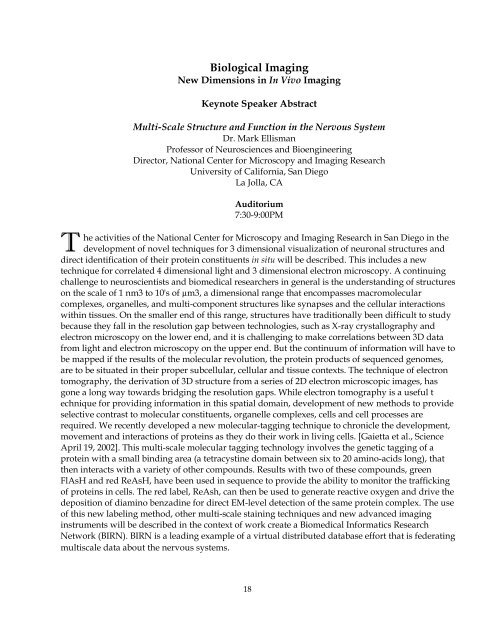Here - WM Keck Laboratory for Biological Imaging - University of ...
Here - WM Keck Laboratory for Biological Imaging - University of ...
Here - WM Keck Laboratory for Biological Imaging - University of ...
- No tags were found...
You also want an ePaper? Increase the reach of your titles
YUMPU automatically turns print PDFs into web optimized ePapers that Google loves.
T<strong>Biological</strong> <strong>Imaging</strong>New Dimensions in In Vivo <strong>Imaging</strong>Keynote Speaker AbstractMulti-Scale Structure and Function in the Nervous SystemDr. Mark EllismanPr<strong>of</strong>essor <strong>of</strong> Neurosciences and BioengineeringDirector, National Center <strong>for</strong> Microscopy and <strong>Imaging</strong> Research<strong>University</strong> <strong>of</strong> Cali<strong>for</strong>nia, San DiegoLa Jolla, CAAuditorium7:30-9:00PMhe activities <strong>of</strong> the National Center <strong>for</strong> Microscopy and <strong>Imaging</strong> Research in San Diego in thedevelopment <strong>of</strong> novel techniques <strong>for</strong> 3 dimensional visualization <strong>of</strong> neuronal structures anddirect identification <strong>of</strong> their protein constituents in situ will be described. This includes a newtechnique <strong>for</strong> correlated 4 dimensional light and 3 dimensional electron microscopy. A continuingchallenge to neuroscientists and biomedical researchers in general is the understanding <strong>of</strong> structureson the scale <strong>of</strong> 1 nm3 to 10's <strong>of</strong> µm3, a dimensional range that encompasses macromolecularcomplexes, organelles, and multi-component structures like synapses and the cellular interactionswithin tissues. On the smaller end <strong>of</strong> this range, structures have traditionally been difficult to studybecause they fall in the resolution gap between technologies, such as X-ray crystallography andelectron microscopy on the lower end, and it is challenging to make correlations between 3D datafrom light and electron microscopy on the upper end. But the continuum <strong>of</strong> in<strong>for</strong>mation will have tobe mapped if the results <strong>of</strong> the molecular revolution, the protein products <strong>of</strong> sequenced genomes,are to be situated in their proper subcellular, cellular and tissue contexts. The technique <strong>of</strong> electrontomography, the derivation <strong>of</strong> 3D structure from a series <strong>of</strong> 2D electron microscopic images, hasgone a long way towards bridging the resolution gaps. While electron tomography is a useful technique <strong>for</strong> providing in<strong>for</strong>mation in this spatial domain, development <strong>of</strong> new methods to provideselective contrast to molecular constituents, organelle complexes, cells and cell processes arerequired. We recently developed a new molecular-tagging technique to chronicle the development,movement and interactions <strong>of</strong> proteins as they do their work in living cells. [Gaietta et al., ScienceApril 19, 2002]. This multi-scale molecular tagging technology involves the genetic tagging <strong>of</strong> aprotein with a small binding area (a tetracystine domain between six to 20 amino-acids long), thatthen interacts with a variety <strong>of</strong> other compounds. Results with two <strong>of</strong> these compounds, greenFlAsH and red ReAsH, have been used in sequence to provide the ability to monitor the trafficking<strong>of</strong> proteins in cells. The red label, ReAsh, can then be used to generate reactive oxygen and drive thedeposition <strong>of</strong> diamino benzadine <strong>for</strong> direct EM-level detection <strong>of</strong> the same protein complex. The use<strong>of</strong> this new labeling method, other multi-scale staining techniques and new advanced imaginginstruments will be described in the context <strong>of</strong> work create a Biomedical In<strong>for</strong>matics ResearchNetwork (BIRN). BIRN is a leading example <strong>of</strong> a virtual distributed database ef<strong>for</strong>t that is federatingmultiscale data about the nervous systems.18





